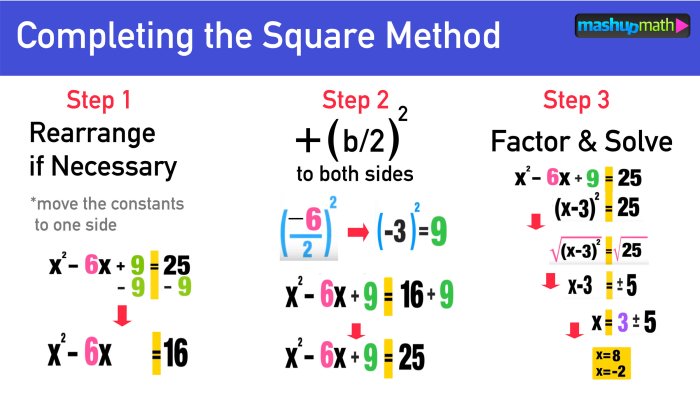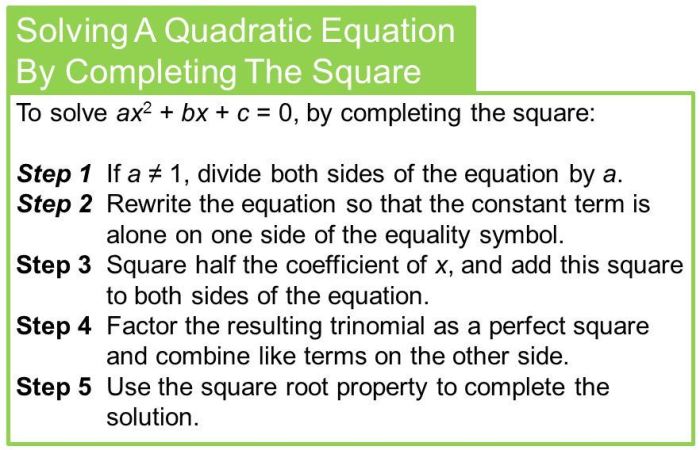Sunil is solving the quadratic equation by completing the square. – Sunil’s method of completing the square is a systematic approach to solving quadratic equations. By manipulating the equation to create a perfect square trinomial, this method provides a straightforward solution to equations that may otherwise be challenging to solve. In this exploration, we will delve into the steps involved in Sunil’s method, its significance, and its applications across various disciplines.
The essence of completing the square lies in transforming a quadratic equation into a form where the left-hand side is a perfect square trinomial. This allows for easy factorization and subsequent determination of the equation’s roots. The formula for completing the square, (b/2)^2, provides the necessary adjustment to achieve this transformation.
Sunil’s Method
Sunil’s method of completing the square is a technique used to solve quadratic equations by transforming them into the form (x + a) 2= b, where a and b are constants. The steps involved in this method are as follows:
- Subtract the constant term from both sides of the equation.
- Divide both sides of the equation by the coefficient of x2.
- Add the square of half the coefficient of x to both sides of the equation.
- Factor the left-hand side of the equation as a perfect square.
- Take the square root of both sides of the equation.
- Solve for x.
For example, to solve the quadratic equation x 2+ 4x – 5 = 0 using Sunil’s method, we would follow these steps:
- Subtract 5 from both sides: x2+ 4x = 5
- Divide both sides by 1: x 2+ 4x = 5
- Add (4/2) 2= 4 to both sides: x 2+ 4x + 4 = 9
- Factor the left-hand side: (x + 2) 2= 9
- Take the square root of both sides: x + 2 = ±3
- Solve for x: x =
2 ± 3
Therefore, the solutions to the equation x 2+ 4x
- 5 = 0 are x =
- 5 and x = 1.
Completing the Square

Completing the square is a technique used to transform a quadratic equation into the form (x + a) 2= b, where a and b are constants. This form is useful for solving quadratic equations because it allows us to use the square root property, which states that if a 2= b, then a = ±√b.
The formula for completing the square is:
x2+ bx + c = (x + b/2) 2
(b2/4) + c
To apply this formula, we follow these steps:
- Subtract the constant term from both sides of the equation.
- Divide both sides of the equation by the coefficient of x2.
- Add (b/2) 2to both sides of the equation.
- Factor the left-hand side of the equation as a perfect square.
Completing the square has several advantages. First, it allows us to solve quadratic equations without using the quadratic formula. Second, it can be used to find the vertex of a parabola, which is the point where the parabola changes direction.
However, completing the square also has some disadvantages. First, it can be more difficult to apply than the quadratic formula. Second, it can lead to complex solutions if the constant term is negative.
Quadratic Equations

Quadratic equations are equations of the form ax 2+ bx + c = 0, where a, b, and c are constants and a ≠ 0. The standard form of a quadratic equation is:
ax2+ bx + c = 0
The components of a quadratic equation are:
- a: the coefficient of x 2
- b: the coefficient of x
- c: the constant term
There are several methods that can be used to solve quadratic equations, including completing the square, the quadratic formula, and factoring. The best method to use depends on the specific equation.
Applications: Sunil Is Solving The Quadratic Equation By Completing The Square.

Completing the square can be used to solve a variety of practical problems in fields such as physics, engineering, and economics.
In physics, completing the square can be used to solve problems involving projectile motion, such as finding the height of a projectile at a given time.
In engineering, completing the square can be used to solve problems involving the design of structures, such as finding the maximum load that a beam can support.
In economics, completing the square can be used to solve problems involving supply and demand, such as finding the equilibrium price of a good.
However, it is important to note that completing the square has limitations. For example, it cannot be used to solve equations that are not quadratic. Additionally, it can lead to complex solutions if the constant term is negative.
Top FAQs
What is the key step in completing the square?
Isolating the quadratic term and adding (b/2)^2 to both sides of the equation.
How does completing the square help solve quadratic equations?
It transforms the equation into a perfect square trinomial, allowing for easy factorization and determination of roots.
What are the limitations of completing the square?
It may not be suitable for equations with complex roots or when dealing with large coefficients.